ASRock Fatal1ty Z77 Professional Review - IDE and Floppy on Z77
by Ian Cutress on May 20, 2012 1:30 PM EST- Posted in
- Motherboards
- ASRock
- Fatal1ty
- Z77
Test Setup
| Processor |
Intel Core i7-3770K ES 4 Cores, 8 Threads, 3.5 GHz (3.9 GHz Turbo) |
| Motherboards |
ASRock Z77 Extreme4 ASUS P8Z77-V Pro Gigabyte GA-Z77X-UD3H MSI Z77A-GD65 ASUS P8Z77-V Deluxe ASRock Fatal1ty Z77 Professional |
| Cooling | Intel All-in-One Liquid Cooler |
| Power Supply | OCZ 1250W Gold ZX Series |
| Memory |
GSkill RipjawsZ 4x4 GB DDR3-2400 9-11-11 Kit GSkill TridentX 2x4 GB DDR3-2666 11-13-13 Kit |
| Memory Settings | XMP (2400 9-11-11) |
| Video Cards |
ASUS HD7970 3GB ECS GTX 580 1536MB |
| Video Drivers |
Catalyst 12.3 NVIDIA Drivers 296.10 WHQL |
| Hard Drive | Micron RealSSD C300 256GB |
| Optical Drive | LG GH22NS50 |
| Case | Open Test Bed - CoolerMaster Lab V1.0 |
| Operating System | Windows 7 64-bit |
| SATA Testing | Micron RealSSD C300 256GB |
| USB 2/3 Testing | OCZ Vertex 3 240GB with SATA->USB Adaptor |
Power Consumption
Power consumption was tested on the system as a whole with a wall meter connected to the OCZ 1250W power supply, while in a dual 7970 GPU configuration. This power supply is Gold rated, and as I am in the UK on a 230-240 V supply, leads to ~75% efficiency > 50W, and 90%+ efficiency at 250W, which is suitable for both idle and multi-GPU loading. This method of power reading allows us to compare the power management of the UEFI and the board to supply components with power under load, and includes typical PSU losses due to efficiency. These are the real world values that consumers may expect from a typical system (minus the monitor) using this motherboard.
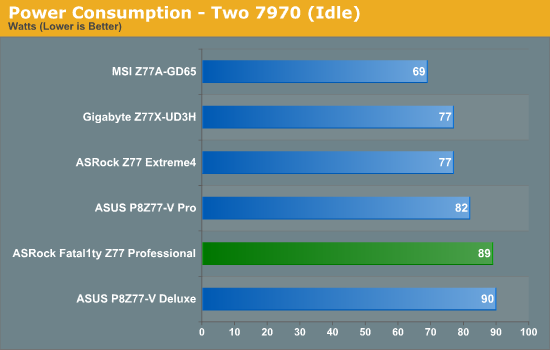
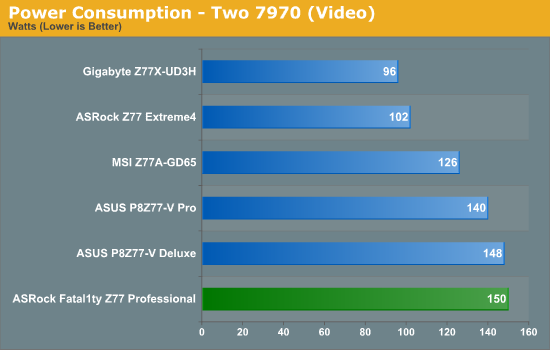
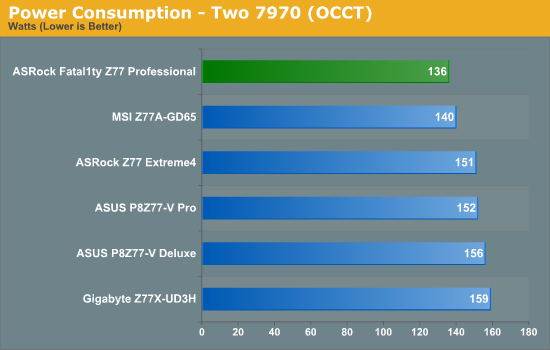
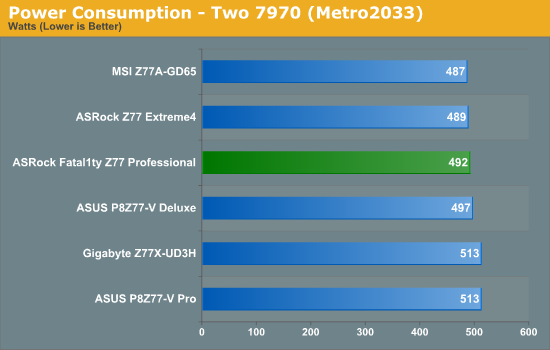
A trend I have noticed over the course of Ivy Bridge testing is that the more power phases there are on a board, the more of the phases are ‘loaded’ during moderate CPU usage, such as playing video. As these phases are at low loading individually, they are relatively inefficient than compared to high loading – this leads to a lot of power draw. As the ASRock Fatal1ty Z77 Professional has a 16+8 phase power delivery, we see this explicitly with 150W system power draw at load – 48W more than the ASRock Z77 Extreme4. There could also be other reasons for this difference, such as different signals to the GPUs regarding power required and how they power gate certain features.
POST Time
Different motherboards have different POST sequences before an operating system is initialized. A lot of this is dependent on the board itself, and POST boot time is determined by the controllers on board (and the sequence of how those extras are organized). As part of our testing, we are now going to look at the POST Boot Time - this is the time from pressing the ON button on the computer to when Windows starts loading. (We discount Windows loading as it is highly variable given Windows specific features.) These results are subject to human error, so please allow +/- 1 second in these results. As requested in my initial Z77 review, we will also be showcasing normal and ‘stripped’ POST times, whereby controllers are turned off in an attempt to get the minimum POST time.
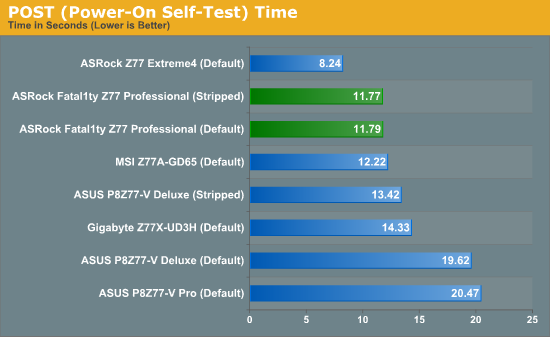
Overall, ASRock are posting some rather reasonable POST times, coming in at almost half the time of the slowest boards. It seems that the controllers on board have little effect on the POST time itself, as the stripped time comes in almost exactly the same as the default time.
Overclocks
Here at AnandTech we want to provide quick and easy ways to determine if a board is good for you (with in-depth analysis of course). So here is a quick round up of our overclocking results. Overclocks are tested for stability with PovRay and OCCT - while these may not be the most strenuous of stability tests, it does offer a quick check for memory errors under high load (and also balances testing time with getting the next board on for review!).
|
CPU Speed (MHz) |
Voltage (Volts) |
PovRay Peak Temp (ºC) |
OCCT Peak Temp (ºC) |
Notes | |
|
ASRock Fatal1ty Z77 Professional |
4700 | 1.200 | 89 | 89 | PLL Overvoltage enabled |
|
ASRock Z77 Extreme4 |
4700 | 1.175 | 86 | 86 | LLC Level 1 |
|
ASUS P8Z77-V Deluxe |
4700 | 1.225 | 89 | 84 | PLL Overvoltage enabled |
|
ASUS P8Z77-V Pro |
4700 | 1.200 | 83 | 86 | PLL Overvoltage enabled |
|
Gigabyte Z77X-UD3H |
4700 | 1.200 | 82 | 86 | LLC Extreme |
|
MSI Z77A-GD65 |
4700 | 1.250 | 90 | - | PLL Overvoltage enabled |










57 Comments
View All Comments
borden5 - Tuesday, May 22, 2012 - link
idk about you guy but i won't buy something that just because of a person image on it, it doesn't feel special about the board since whenever i think of my motherboard that guy pop up instead of something else, i'd rather prefer asrock sticker on it than this crap.kam24 - Tuesday, May 22, 2012 - link
I was looking through the Z77's on Newegg and this caught my attention because of IDE. I'll probably retire my old IDE hard drives along with my dusty old floppy (my current OS drive is SATA and I'll keep that for extra storage)...but I have two IDE optical drives with custom painted face plates. Nothing fancy but I'd like to reuse them. I was disappointed though with how the board fared in this review. When paying this much for a board I'd expect better power management and more polish. I don't care either way about the branding aspect.I'd just like to, as someone else mentioned, be able to take a bare bones board and add what I'd like. I wonder how much it would cost a company like MSI or Asus to offer that. I'd pay a little extra for a board perfect for me.
frankanderson - Wednesday, May 23, 2012 - link
You guys know that they do sell IDE enclosures for old school drives and external DVDRW/BR devices right? I have a external usb floppy which I only use to boot up old motherboards that don't like to boot off USB thumb drive for some reason, or insert SCSI driver into floppy.. I just don't like having a floppy in my system anymore, I don't even have a DVD installed, the DVD is installed in my Home Server, I'll network whatever data over that I need, most of my games and apps are digital copies now, they are downloaded in a simple install package and left on my server, can't remember the last time I actually bought a software in a box (I think it was Windows 7 Ulitimate which was years ago)..Another thing is "Wendal" is a great gamer, a pro gamer and probably one of the greatest out there, sure it's a dream that someone can do what they love and still make a living from it.. I just don't believe that because it's "endorsed" by him, means that it's the best product..
And where I am from, most "endorsed" products are just for publicity, us as consumers don't really believe they really use that product at home, even if it's free.. just my $0.02
smithrd3512 - Wednesday, May 23, 2012 - link
Looks like I can put a 5.25" floppy on my new build with this board.Would give the kids something to ask me what the heck is a floppy.
redwolfe98 - Monday, June 4, 2012 - link
i disagree that a floppy connector is not needed.. it is needed if you are running "windows xp", as i am..read how to flash the bios on a MSI motherboard, which doesn't have a floppy connector, when running win xp:
"get yourself an external floppy drive with a USB connector; add files to floppy disk so that the external floppy drive is recognized (if it works as intended); if all goes well ie if the external floppy drive is recognized, proceed to flash bios..
i remember when Dell quit shipping floppy drives.. lots of people weren't able to install the drivers that were needed for "sata", because they didn't have a floppy drive, and, consequently, had to switch things in the bios to "IDE compatibility"..
i don't see any reason for not including a floppy connector, at least not until windows xp is dead and buried and long forgotten..
i also like using PS/2 connections for mice and keyboards..
spencerp - Monday, June 4, 2012 - link
I bought a gamer computer back in the day (the HP Blackbird 002 with Voodoo DNA). It has an optical drive with a proprietary LED/button AND it's IDE. It still plenty fast for the occasional optical drive use.Due to the ASRock motherboards supporting both the IDE and legacy CPU coolers, it has allowed me to continue to breath new life into my hardware and use my Blackbird (I have the older, but nearly identical z68 version).
It's got pretty heavy branding which is extremely obvious out of the box. However, when the video cards and CPU cooler is installed, it's not as bad.
http://www.flickr.com/photos/spthealien/6387705167...
It has been rock solid.
DreadStorm - Friday, May 2, 2014 - link
Instead of bitching about WHY people use floppies and EIDE, why not just accept the fact that some of us still do - and leave it at that? There are several useful reasons to still use a floppy - or other obsolete removable media - the main one being that no one else has such drives, and what better way to secure data than to place it on a medium that no one else has? USB, Firewire, rack-mounted hard drives, all suffer the same similarity: Everyone has them, and can connect to and try to crack into them. With a floppy, Orb, Zip, Jaz, hell even a 5.25", no one uses anymore, so it makes the data that much more secure against hack attempts. "Old school" hardware still has a number of useful applications nowadays. Personally, I have about 12 different obsolete removable media drives connected to my Fatal1ty Z77 Pro (most via SCSI card). And all work like a champ - except for the floppy drive controller on this board, which had never worked since day one. For the floppies, I have an older P4 machine networked together for those, because of the floppy connector issue on this board.If they ever got it fixed, I wouldn't need the older machine anymore. But other than that, I have no intention of relieving myself of older media. If for nothing else than nostalgia and uniqueness.